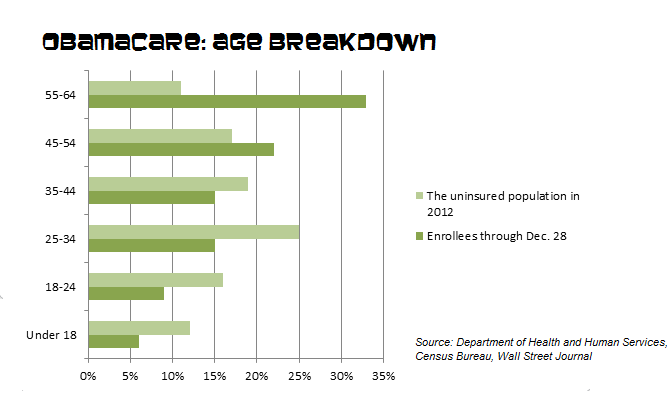Since state and federal health exchanges rolled out Oct. 1, the insurance industry has wanted to know one thing: the number of young people signing up for coverage.
A lot is riding on those initial figures and this week, the White House has revealed its first look.
Just under 25% of the roughly 2.2mn Americans who signed up for private insurance plans were the nation’s so-called “young invincibles”—healthy individuals between the ages of 18 and 34. By contrast, an estimated 55% were between the ages of 45 and 64.
Those figures are fairly close to the
Kaiser Family Foundation’s December estimate that a quarter of enrollees would fall in the age 18 to 34 bracket. According to Kaiser, if these levels hold through March, carriers will have to raise premiums by just 2.4% in 2015 to cover the shortfall caused by enrollment weighted heavily towards the older population.
At these levels, Kaiser believes, a “
death spiral” triggered by the Affordable Care Act is unlikely.

Teri Gutierrez, an expert on high-risk pools with the National Association of Health Underwriters, said she will be concerned if the figures don’t include more young invincibles by the March enrollment deadline, however.
“If we end up with 3mn on the marketplace between now and the end of March, but 50% of those are over 30 or 40, that’s going to create higher rates going into 2014,” Gutierrez said. “If the rates go up and keep going up, [paying the tax penalty for going uninsured] is going to become even a more favorable option than buying coverage.”
David A. Shore, president of the Massachusetts Association of Health Underwriters, is volunteering in his spare time to encourage young people to sign up for health coverage.
However, he believes there are serious roadblocks standing in the way—namely,
the option to keep non-compliant plans through 2014 and the relative weakness of the tax penalty put in place to deter individuals from going uninsured.
“The individual mandate is necessary, but the penalty is week,” Shore said. “In the absence of clear and reliable rules from the administration, as select states move forward with ‘if you like it, you can keep it,’ 2014 premiums may be insufficient.”
Note: The administration figures do not reflect data from Minnesota, Nevada and Oregon, whose state exchanges did not compile information based on age.


